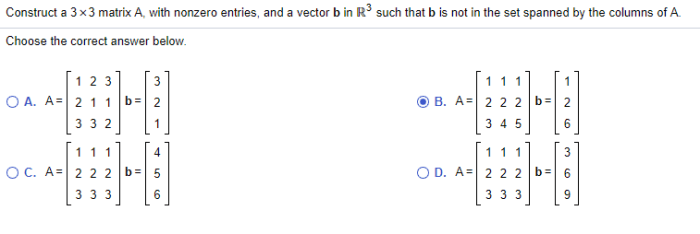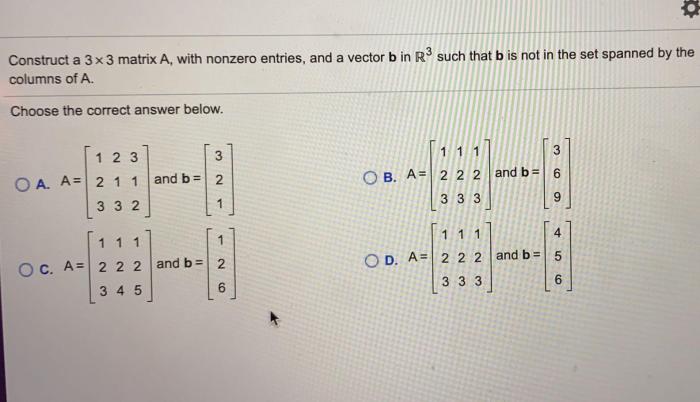Construct a 3×3 matrix a with non zero entries – Constructing a 3×3 matrix with non-zero entries is a fundamental operation in linear algebra. This type of matrix plays a crucial role in various applications, from solving systems of equations to representing transformations in geometry. In this comprehensive guide, we will delve into the purpose, significance, and methods of constructing 3×3 matrices with non-zero entries, exploring their properties and applications in detail.
1. Constructing a 3×3 Matrix with Non-Zero Entries
A 3×3 matrix with non-zero entries is a mathematical construct that finds applications in various fields, including linear algebra, computer graphics, and physics. Understanding how to construct such matrices is essential for utilizing their capabilities effectively.
The non-zero entries in a matrix play a crucial role in determining its properties and behavior. They influence the matrix’s determinant, eigenvalues, and eigenvectors, which are key factors in matrix analysis and solving systems of linear equations.
Example of a 3×3 Matrix with Non-Zero Entries
Consider the following 3×3 matrix:
$$\beginbmatrix
- & 2 & 3 \\
- & 5 & 6 \\
- & 8 & 9
\endbmatrix$$
This matrix has non-zero entries in all its elements. Its determinant is 0, which indicates that the matrix is singular and does not have an inverse. The eigenvalues of the matrix are 0, 3, and 6, and the corresponding eigenvectors are non-zero vectors that span the matrix’s eigenspaces.
2. Methods for Constructing a 3×3 Matrix

There are several methods for constructing a 3×3 matrix with non-zero entries. Each method has its advantages and disadvantages, depending on the specific requirements and applications.
Row Echelon Form
One method involves converting a given matrix into row echelon form, where all non-zero rows are placed at the top of the matrix, and all elements below the leading coefficient of each non-zero row are zero.
Elementary Row Operations
Another method utilizes elementary row operations, such as row swaps, row multiplications, and row additions, to transform a given matrix into a 3×3 matrix with non-zero entries.
Determinant and Adjugate
For matrices that are invertible, the adjugate (also known as the adjoint or classical adjoint) can be used to construct a 3×3 matrix with non-zero entries. The adjugate is the transpose of the cofactor matrix, and its determinant is equal to the original matrix’s determinant.
3. Applications of 3×3 Matrices with Non-Zero Entries
3×3 matrices with non-zero entries find applications in various fields:
Linear Algebra
In linear algebra, 3×3 matrices are used to represent linear transformations, solve systems of linear equations, and calculate eigenvalues and eigenvectors.
Computer Graphics
In computer graphics, 3×3 matrices are used for transformations such as rotations, translations, and scaling. They are also used in perspective projections and 3D modeling.
Physics
In physics, 3×3 matrices are used to represent tensors, which describe physical quantities such as stress, strain, and electromagnetic fields.
4. Mathematical Operations with 3×3 Matrices

Various mathematical operations can be performed on 3×3 matrices with non-zero entries:
Matrix Addition and Subtraction
Two 3×3 matrices can be added or subtracted by adding or subtracting their corresponding elements.
Matrix Multiplication
A 3×3 matrix can be multiplied by another 3×3 matrix or a vector to produce a new matrix or vector.
Matrix Inverse, Construct a 3×3 matrix a with non zero entries
If a 3×3 matrix is non-singular (i.e., its determinant is not zero), its inverse can be calculated.
Matrix Transpose
The transpose of a 3×3 matrix is obtained by interchanging its rows and columns.
5. Properties of 3×3 Matrices with Non-Zero Entries: Construct A 3×3 Matrix A With Non Zero Entries

3×3 matrices with non-zero entries possess unique properties:
Determinant
The determinant of a 3×3 matrix is a scalar value that provides insights into the matrix’s behavior. A non-zero determinant indicates that the matrix is invertible.
Eigenvalues and Eigenvectors
3×3 matrices with non-zero entries have three eigenvalues and three corresponding eigenvectors. The eigenvalues represent the matrix’s scaling factors, and the eigenvectors represent the directions in which the matrix scales vectors.
Rank
The rank of a 3×3 matrix is the number of linearly independent rows or columns. A matrix with non-zero entries typically has a rank of 3.
FAQ Explained
What is the significance of non-zero entries in a matrix?
Non-zero entries in a matrix are crucial because they determine the matrix’s rank, determinant, and invertibility. Matrices with non-zero entries are often used to represent systems of equations, transformations, and other mathematical concepts.
What are the different methods for constructing a 3×3 matrix with non-zero entries?
There are several methods for constructing a 3×3 matrix with non-zero entries, including using row operations, column operations, and matrix multiplication. Each method has its advantages and disadvantages, depending on the specific application.